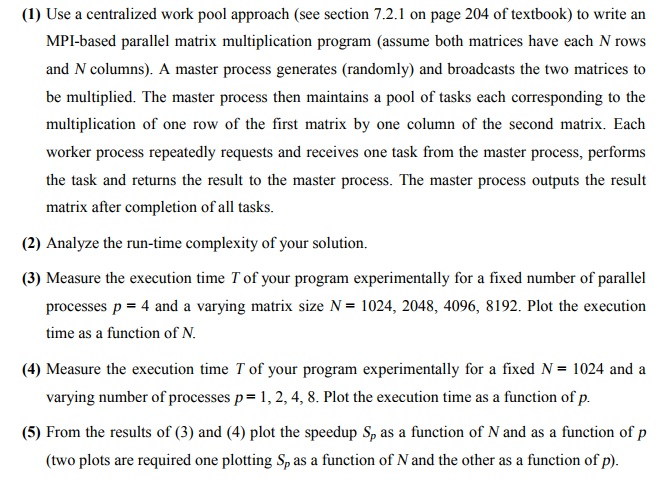
(1) Use a centralized work pool approach (see section 7.2.1 on page 204 of textbook) to write an MPI-based parallel matrix multiplication program (assume both matrices have each N rows and N columns). A master process generates (randomly) and broadcasts the two matrices to be multiplied. The master process then maintains a pool of tasks each corresponding to the multiplication of one row of the first matrix by one column of the second matrix. Each worker process repeatedly requests and receives one task from the master process, performs the task and returns the result to the master process. The master process outputs the result matrix after completion of all tasks. (2) Analyze the run-time complexity of your solution. (3) Measure the execution time T of your program experimentally for a fixed number of parallel processes p - 4 and aryingatris size N- 1024, 048, 409%, 8192. Plot the execution time as a function of N. (4) Measure the execution time T of your program experimentally for a fixed N- 1024 and a varying number of processes p= 1,2,4,8. Plot the execution time as a function ofp. (5) From the results of (3) and (4) plot the speedup Sp as a function of N and as a function of p (two plots are required one plotting Sp as a function of N and the other as a function of p). (1) Use a centralized work pool approach (see section 7.2.1 on page 204 of textbook) to write an MPI-based parallel matrix multiplication program (assume both matrices have each N rows and N columns). A master process generates (randomly) and broadcasts the two matrices to be multiplied. The master process then maintains a pool of tasks each corresponding to the multiplication of one row of the first matrix by one column of the second matrix. Each worker process repeatedly requests and receives one task from the master process, performs the task and returns the result to the master process. The master process outputs the result matrix after completion of all tasks. (2) Analyze the run-time complexity of your solution. (3) Measure the execution time T of your program experimentally for a fixed number of parallel processes p - 4 and aryingatris size N- 1024, 048, 409%, 8192. Plot the execution time as a function of N. (4) Measure the execution time T of your program experimentally for a fixed N- 1024 and a varying number of processes p= 1,2,4,8. Plot the execution time as a function ofp. (5) From the results of (3) and (4) plot the speedup Sp as a function of N and as a function of p (two plots are required one plotting Sp as a function of N and the other as a function of p)







